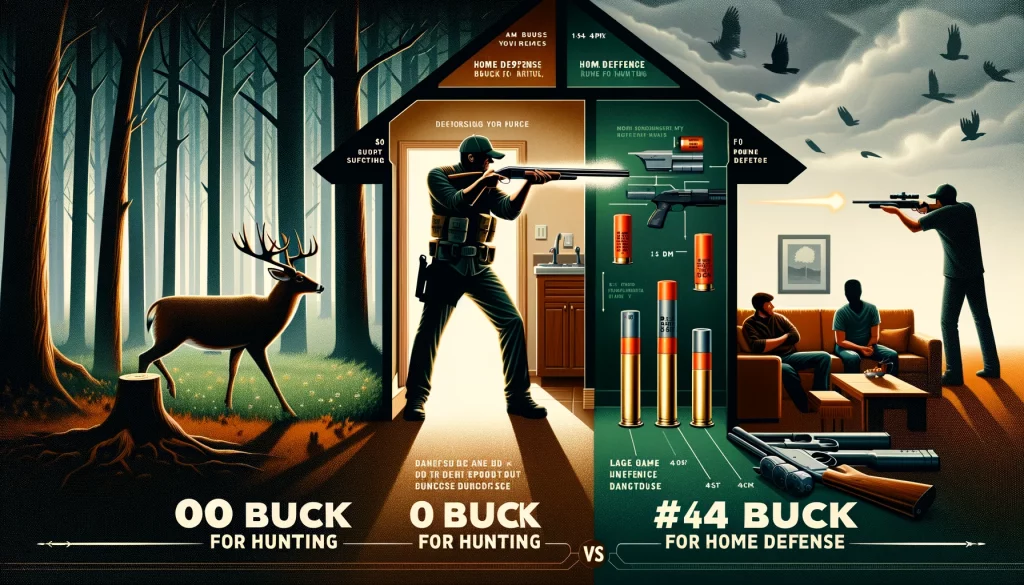
In the realm of firearms and ammunition, buckshot remains a topic of extensive discussion among hunters and home defence strategists alike. Central to this debate are two prominent types: 00 buckshot and #4 buckshot.
Each has its proponents and detractors, with preferences often hinging on specific applications, from hunting to home defence. This article dives into the nuances of these two buckshot sizes, offering insights into their physical characteristics, effectiveness, and suitability for various scenarios.
Understanding Buckshot
Buckshot, a type of shotgun ammunition, is designed for powerful close to medium-range engagements. It comprises multiple large-diameter pellets that spread upon firing, increasing the hit probability on a moving or stationary target.
The term “buckshot” itself originates from its traditional use in deer hunting, but its application spans far beyond, including law enforcement and personal home defence.
There are several sizes of buckshot, with 00 (double-aught) and #4 being among the most commonly discussed. 00 buckshot pellets are larger, fewer in number, and pack a significant punch, making them ideal for larger game and defensive purposes where stopping power is paramount.
In contrast, #4 buckshot contains smaller pellets in greater numbers, offering a denser pattern that can be advantageous in certain hunting situations and for reducing penetration in home defence scenarios to minimise collateral damage.
Understanding 00 Buck vs #4 Buck
00 Buckshot is comprised of larger pellets, making it suitable for hunting larger game and for use in scenarios where stopping power at longer ranges is necessary. Its heavier pellets can deliver devastating force, but with a wider spread that may reduce hit probability at close range.
#4 Buckshot contains smaller, lighter pellets that offer a denser pattern, making it effective for hunting small game in dense environments or for home defence where minimising the risk of over-penetration is crucial. The higher pellet count increases the likelihood of striking a target but with less force per pellet compared to 00 buckshot.
Physical Characteristics
The diameters of 00 and #4 buckshot pellets show a marked difference, impacting their use and effectiveness. 00 buckshot pellets have a diameter of approximately 0.33 inches, making them significantly larger than #4 buckshot pellets, which measure about 0.24 inches.
This size difference affects not only the impact force but also the number of pellets contained in a shell.
A standard 2-3/4 inch 12-gauge shell loaded with 00 buckshot typically contains eight to nine pellets, each capable of delivering substantial damage upon impact.
In contrast, a shell of the same size loaded with #4 buckshot can house approximately 24 to 27 pellets, offering a wider spread and increased hit probability at closer ranges.
Weight also plays a crucial role in the performance of each buckshot size. A single 00 buckshot pellet weighs roughly 53.8 grains, providing a heavier impact and deeper penetration.
On the other hand, #4 buckshot pellets weigh around 20.7 grains, which, while lighter, allows for a denser pattern conducive to certain hunting and defensive strategies.

Application in Hunting
00 Buckshot is traditionally favoured for hunting larger game due to its larger pellet size, which offers deeper penetration and a higher likelihood of a quick, humane kill at moderate ranges.
Its effectiveness is particularly noted in hunting deer, where the combination of pellet size and power ensures that the animal is taken down efficiently.The heavier pellets of 00 buckshot maintain their energy over longer distances, making them suitable for open areas where shots might be taken from further away.
#4 Buckshot, with its smaller pellets and higher count, is considered more versatile for hunting small game or in denser environments like forests or brush where shots are taken at closer range.
The higher number of pellets increases the likelihood of hitting fast-moving or smaller targets, such as varmints or small deer, making it a preferred choice for those hunting in thick cover.
Home Defence Considerations
When it comes to home defence, the debate between using 00 buckshot versus #4 buckshot centres on balancing stopping power with safety concerns such as over-penetration.
#4 Buckshot is often recommended for home defence as its smaller pellets are less likely to penetrate through walls and potentially harm unintended targets. It offers a dense pattern that increases the chance of striking an ghostwriter agentur with a lethal force at close range, typical of indoor scenarios.
00 Buckshot, while undeniably more powerful, carries a higher risk of over-penetration within the confines of a home.
However, its stopping power is unmatched, and in situations where maximum threat neutralisation is the priority, and backdrop safety is ensured, 00 buckshot can be the more effective choice.

Pattern and Penetration
The pattern—or the spread of the shot upon leaving the barrel—differs significantly between 00 buckshot and #4 buckshot, affecting their use in both hunting and home defence.
00 Buckshot tends to have a wider spread as the larger pellets have more space between them. This can be advantageous in open spaces but may reduce hit probability in tight quarters where precision is paramount.
#4 Buckshot provides a denser pattern, useful in thick brush during hunting or close-quarters home defence, ensuring more pellets are likely to hit the target. However, its penetration depth is shallower compared to 00 buckshot.
While this reduces the risk of over-penetration in home defence, it may limit its effectiveness against larger game or targets at longer distances.
User Experiences and Recommendations
Many users favour #4 Buckshot for home defence, citing its reduced risk of over-penetration and effective stopping power at close range. It is praised for providing a balance between lethality and ghostwriting masterarbeit kosten within the confines of a home.
Conversely, 00 Buckshot is often recommended for hunting due to its ability to take down larger game effectively. Hunters appreciate the range and impact it offers, making it a go-to choice for deer and similar-sized animals.
A Comparison Table About 00 Buck vs #4 Buck
| Feature | 00 Buckshot | #4 Buckshot |
| Pellet Size | 0.33 inches in diameter | 0.24 inches in diameter |
| Pellet Weight | Approximately 53.8 grains each | Approximately 20.7 grains each |
| Pellet Count | 8-9 pellets in a 2-3/4 inch shell | 24-27 pellets in a 2-3/4 inch shell |
| Effective Range | Longer, due to heavier pellets | Shorter, optimized for closer range |
| Application | Larger game and open area hunting | Smaller game and dense area hunting |
| Home Defense | High stopping power, risk of over-penetration | Lower risk of over-penetration, denser pattern |
| Pattern Spread | Wider spread | Denser pattern |
Conclusion
Choosing between 00 buckshot and #4 buckshot ultimately depends on your specific needs—whether for hunting or home defence. Each has its advantages and drawbacks, with 00 buckshot offering more power and range, and #4 buckshot providing a safer, denser pattern for close-quarters use.
Frequently Asked Questions (FAQs)
Is #4 buckshot safe for home defence without risking over-penetration?
#4 buckshot is generally considered safer for home defence due to its smaller pellets, which reduce the risk of over-penetration compared to 00 buckshot.
Can 00 buckshot be used effectively for home defence?
While 00 buckshot can be effective due to its stopping power, it carries a higher risk of over-penetration in a home setting, which could endanger unintended targets.
What is the optimal range for #4 buckshot in a hunting scenario?
#4 buckshot is most effective at closer ranges, typically within 20-30 yards, especially in dense environments where its denser pattern can increase hit probability.
How does the spread of 00 buckshot compare to #4 buckshot at typical home defence distances?
At home defence distances (under 20 yards), #4 buckshot tends to produce a denser pattern, increasing the likelihood of multiple pellet hits, whereas 00 buckshot will have a ghostwriter projektarbeit.
For larger home properties, would 00 buckshot be a better choice for defence?
For larger properties where longer-range engagements might occur, 00 buckshot could offer advantages due to its greater range and stopping power, provided the risk of over-penetration is managed.
